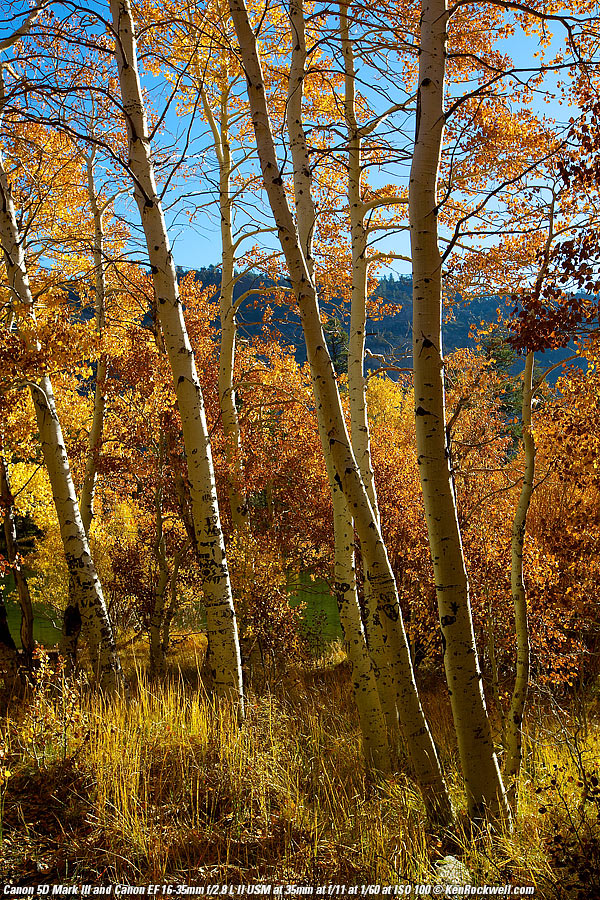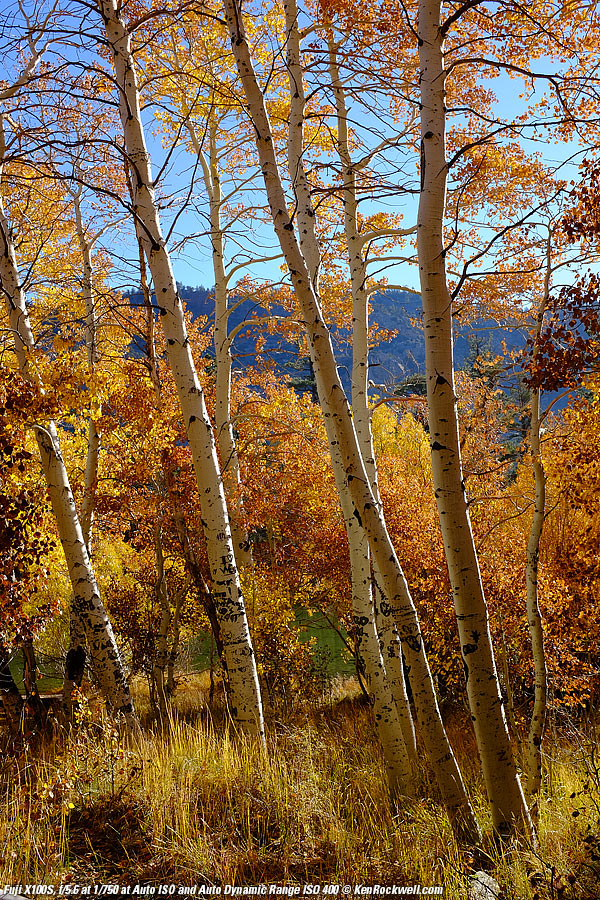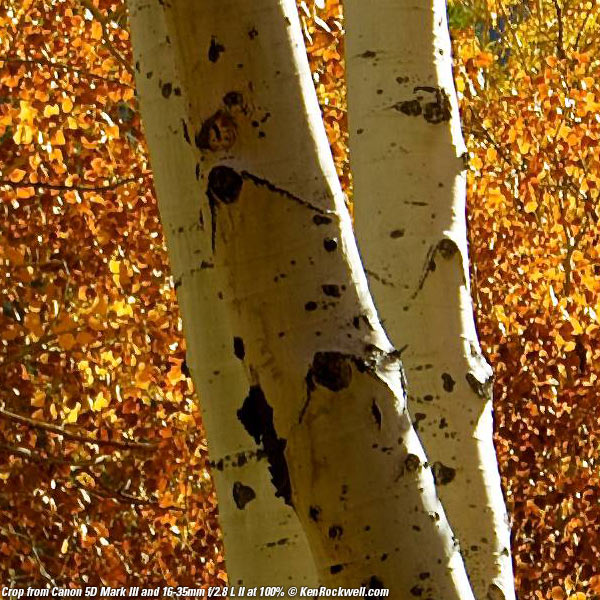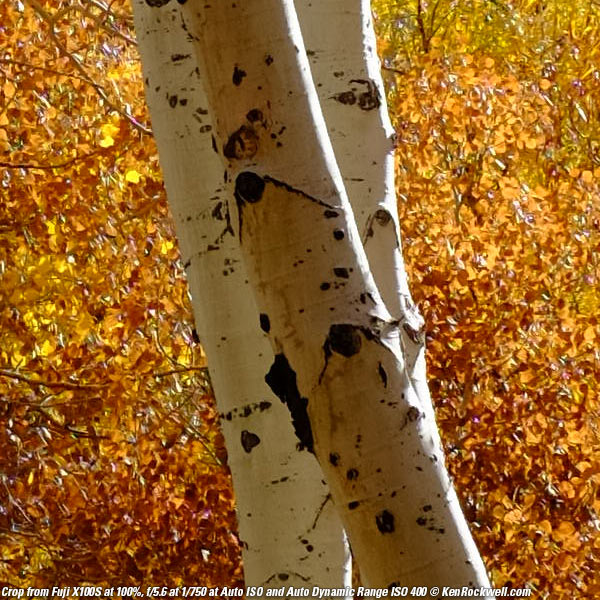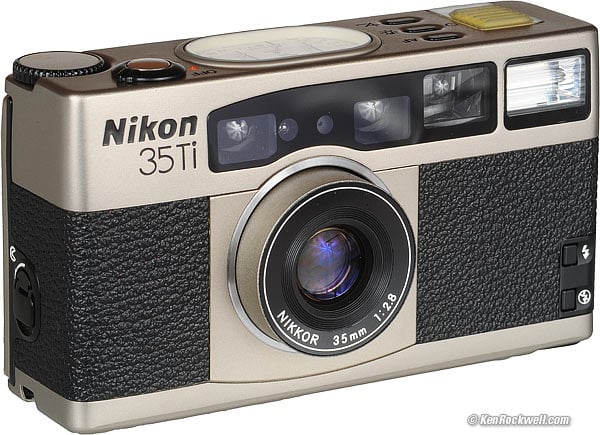Home Donate New Search Gallery Reviews How-To Books Links Workshops About Contact
Canon 5D Mark III
versus
Fuji X100S
versus
Nikon 35Ti
© 2014 KenRockwell.com. All rights reserved.
This free website's biggest source of support is when you use any of these links to approved sources when you get anything, regardless of the country in which you live — but I receive nothing for my efforts if you take a chance and buy elsewhere. I get no government hand-outs and run no pledge drives to support my research, so please always use any of these links to approved sources for the best prices, service and selection whenever you get anything. Thanks for helping me help you! Ken.
January 2014 Canon Reviews Fuji Reviews Nikon Reviews All Reviews
Canon 5D Mark III (56.1 oz./1,590g wet, with lens)
Fuji X100S (15.7oz./445g wet with lens)
Nikon 35Ti (13.1 oz./372.1g wet with lens)
Introduction top
As I was editing my shots from my October 2013 trip to California's Eastern Sierra (under construction, duh, since I'm still editing), I was astounded at how identical two frames from these two different cameras looked.
Zoomed in, one was obviously sharper than the other, but overall, it's amazingly the same shot. Click any for the camera-original © JPG file.
Ha! I also shot it in my Nikon 35Ti on Fuji Velvia 50. (bigger or Full-resolution.) Not only does it look better than the digital cameras after being scanned, the original film looks even better on the light table or projected; it knocks the digital stuff out the window. Any scan is a sad attempt to reproduce what's on the film, whose 10,000:1 dynamic range (4.0 D log 10) exceeds any digital monitor like what you're viewing right now.
Anyway, here are crops from 100% images from the center of each digital shot:
Camera-original © JPG from Canon 5D Mark III (4.8 MB, 22 MP).
Camera-original © JPG from Fuji X100S (4.1 MB, 16 MP).
Analysis top
Goodness gracious, the X100S image makes the state-of-the-art Canon 5D Mark III look broken!
Why is this?
Lenses
I shot the Canon EF 16-35mm f/2.8 L II at its 35mm setting, which sees the same felid-of-view as the Fuji's 23mm lens sees on the X100S.
The Canon image isn't as sharp as the Fuji because the Canon EF 16-35mm f/2.8 L II zoom lens isn't as sharp as the Fuji X100S' fixed 23mm f/2 ASPH lens.
Canon has never made any really great ultrawide zooms; the 17-40 L and 16-35mm L II are Canon's best, but neither is that great when compared to fixed lenses like the 20mm f/2.8 USM or the Nikon 14-24 or 16-35 VR. This is why some Canon shooters look to Zeiss or use Nikon lenses on adapters.
So what if the Canon has a bigger sensor and more pixels? If the lenses aren't up to it, it doesn't matter how good is the sensor. Ultrawide zooms are the most difficult lenses to design and manufacture, and are always the weakest lens in any maker's lineup.
Sensors
The Canon has more pixels, but it also has an anti-alias filter, while the Fuji sensor uses a unique color array that does away with the need for an anti-alias filter.
Shot in real-world conditions, this sharpness difference becomes painfully obvious.
DSP and Image Processing
It doesn't matter how good is your sensor if the lens isn't up to it.
It doesn't matter how good is your sensor if the camera's image processing doesn't do an artful job. Canon and Nikon do great jobs, while third-tier brands like Sony just can't nail the great colors that Nikon and Canon do as often. There is a lot of trade-secret sauce in the top-tier cameras to get the subtle and strong colors we demand.
See how the shadows are wonderfully detailed in the Fuji shot, while they are darker and with less form in the Canon shot? This is because I shoot with my Fuji set to Auto DR (Dynamic Range). In this mode, each shot on the Fuji is automatically analyzed before being shot and automatically shot with just the right exposure and tweaked to retain highlights and shadows.
Canon isn't as good at this.
Notice how the shadows are fuller in the Fuji, while the skies are about as bright.
Look also how the Fuji retains detail into brighter highlights than the Canon.
In these shots both cameras were set to STANDARD picture control. I had my Fuji set to +2 Color Saturation. I set my Canon at +3 saturation and I think 6 sharpening.
ISO
Did you notice that the Canon is shot at ISO 100 and the Fuji at ISO 400, yet the Fuji still looks cleaner and smoother, as well as sharper?
I shot each in Auto ISO. The Canon stayed at ISO 100 in daylight, while the Fuji's Auto Dynamic Range dropped the exposure to retain highlight detail and bumped up to ISO 400 so retain the shadows.
As we can see, the DX sensor of the Fuji trounced Canon's full-frame. Fuji uses different VooDoo than Canon, and Fuji's VoodOo sensor is always giving me super-clean results at crazy ISOs. It just does. As an artist, we don't care how it works; we select our tools to get the look we demand.
Nikon 35Ti
Nikon 35Ti (13.125 oz./372.1g with film and CR123 battery, about $300 used).
Scanned film looks good here on your digital display, but the original film looks even better in person on the light table or projected, which I can't show here.
In person, film sings. It glows. It's why I shoot film for my serious work. This is art, and for my art, film just looks better — but that's just me. How to get started with film now.
Let's be honest here: look at how many more different colors we can see in the scan from the 35Ti. Most of the colors in the digital snaps look like the same yellow-green color, while in the 35TI scan the differences between the yellow foreground and orange background are obvious, while they looked like the same color in the digital snaps.
Likewise, while the sky looks like the same color in each of the digital snaps, it clearly fades from cyan to blue in the Velvia 50/35Ti work.
I bet you never saw the green behind the yellow in the digital shots, while the scan of the Velvia 50/35Ti scan makes it obvious.
The 35Ti also has just the right light distribution to focus the viewer's attention to the middle of the image, making it glow and keeping the viewer's eyes from leaving, while the digital cameras anesthetized the light by removing the lens' natural falloff.
In the scan of the film work there are a thousand clearly delineated shades of different colors, while by comparison the digital snaps all look like the same greenish yellow and blue, just different brightnesses of the same color. The original film looks even better! Just think how much better the 35Ti would look if I used a real drum scan instead of an inexpensive NCPS minilab scan as shown here.
So why does no one else show this? Easy: 1.) other private websites are run by computer hobbyists who like to play with computers, not working, award-winning photographic artists who have no idea how to make a website, and 2.) commercial and camera-company sites don't want you to realize that you can get better results with a $10 roll of film in a $250 camera than any state-of-the-art $2,000 digital camera that they'd rather sell you today. As always, follow the money.
Don't even ask me how much more fun the 35Ti is to shoot; it's a hoot! If you're having fun, you're shooting better.
But what if?
Anyone who works in a cubicle has the time to play Monday-morning quarterback and ask "but what if you...?" as they read this indoors on someone else's time.
Real-world shooting is just like being a sniper: you take your shot, then immediately run like crazy to your next position. You observe your target carefully, take your next shot, and run like crazy again. Any time you're fiddling with your gear you're not observing your target and become a target yourself. In the real world, you pay attention to your subject and don't have the extra minutes that cube-dwellers have to say "what if." Gear choices are made before you deploy; when you're shooting, you're thinking about your subject and not about your gear.
Here are some of the top reasons I shot it as I did:
Why not the EF 35mm f/1.4 L or EF 24-70mm f/2.8 L II USM?
Good question, especially since I own both these lenses, I had them both with me on this trip and either is much sharper than any ultrawide zoom.
Easy answer: because when you deploy for nature shooting, you bring a wide zoom, a tele zoom, and you're done. Those other heavy lenses were back in some other bag. I pull out the 35/1.4 for night shots and leave everything else back, while the 24-70 I brought just in case someone needed to borrow a lens. I don't use midrange zooms for nature; I brought a plastic 50/1.8 II in case I needed something between 35 and 70mm.
I use my 16-35/2.8 L II because it takes the place of two lenses (my 20/2.8 USM and 35/1.4 L) and handles faster than having to jack around between lenses.
If I was a typical hobbyist with too much gear who parks his BMW, Range Rover or Porsche SUV at a park turnout and snaps away for a half hour from the same exact spot with all his exotic lenses, I'd never make any good shots. To shoot well you have to be light on your feet so you can walk around and get to more locations with more creative energy. An iPhone in the right place at the right time makes much better shots than anything at a park turnout. Not that these shots above are any good, but at least I was out getting my feet dirty in the woods.
So yes, the Canon shot might have been as good as the Fuji if I just happened to use a different lens — but I didn't, and I don't use those lenses in the field since I'd have to carry even more lenses with them if I did. See Assembling a System.
But didn't f/11 dull the Canon shot?
If I was shooting flat test charts indoors with a perfect lens then diffraction would dull it, but the 16-35mm L II just happens to be at its sharpest at f/11, which is why I usually shoot this lens in Av mode at f/11 as I did here.
The full-frame camera also requires a smaller aperture for the same depth of field compared to the smaller format Fuji. In fact, the Fuji at f/5.6 has deeper effective depth-of-field than the Canon does at f/11: just look at the ridge of trees in the background! You can see the branches in the Fuji shots, while the trees are just blurs in the Canon shot. In this case, the Canon shot is softer due to the anti-aliasing filter, not the lens. The Canon shot looks cartoonish (sharp outlines without texture inside) due to its DSP.
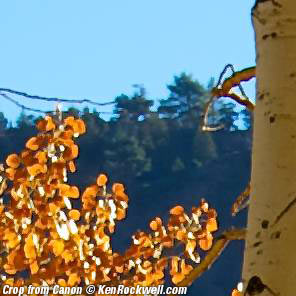 |
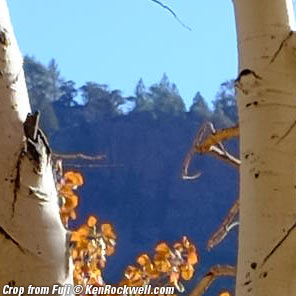 |
But why not shoot raw?
While those who don't have to produce pictures in order to eat may have the time for computer work, I don't: I have to produce to eat.
Honestly though, I did shoot a lot of this in raw. I noticed how these shots matched in my folder containing all the best versions of of all the shots after I'd processed my raw files. For these shots, the camera-original JPGs looked better.
It turns out that the Canon 5D Mark III has better color rendition direct from camera as JPGs than what I get from CR2 via Apple Aperture 3. In this case, Canon has better secret sauce than Apple does for this camera, at least for my eyes, so the JPGs look better than raw.
I also shot everything on the Fuji in RAF, but I have no meaningful software that can read the files! The Fuji uses a unique color filter arrangement on its VooDoo sensors, so most software can't decode the Fuji RAP files. In any case, Fuji does an extraordinary in-camera job of making JPGs as sharp as external software would from the RAF files. I have this shot from the X100S also as an RAF file, but who cares, it still wins even as a JPG.
I hear Fuji is working on a newer "T" sensor based on Kodak's T-grains that will improve light sensitivity. These raw files will add a T to the file suffix, and the new files will end with ".TRAF" Fuji is trying to get you people to pay more attention to FARTing before shooting so your pictures won't stink.
But why not bring three trucks of grip, lighting and gennys?
If this was a serious shoot, I'd bring a few 6-ton trucks and crew to light it. There's nothing so big that more ARRI lights couldn't help. I could have filled in the shadows on the aspen trunks and made them bluer with great detail instead of dim orange.
Given a large enough budget, I can do anything. Lighting is far more important than the camera. In this case, I was off in the woods trying to enjoy myself and this is what I got.
Recommendations top
Intro Specs Performance Compared Usage Recommendations More
I don't call the Fuji X100S the world's best digital camera for nothing.
The Canon 5D Mark III is the worlds best DSLR, and in this case, the Fuji's image quality is even better than a DSLR mostly because Canon's ultrawide zooms are their weakest lenses.
Most of the time two real-world shots made on two cameras are so different that comparisons make no sense. In this case, it jumped out at me as to how similar they were overall, and I wanted to share them. Of course if you set each camera differently than I did you'll get different results. This shows how these two cameras actually brought back game from a real field session in which each camera was configured as I actually shoot it, not just set to irrelevant defaults.
Help me help you top
I support my growing family through this website, as crazy as it might seem.
The biggest help is when you use any of these links when you get anything, regardless of the country in which you live. It costs you nothing, and is this site's, and thus my family's, biggest source of support. These places have the best prices and service, which is why I've used them since before this website existed. I recommend them all personally.
If you find this page as helpful as a book you might have had to buy or a workshop you may have had to take, feel free to help me continue helping everyone.
If you've gotten your gear through one of my links or helped otherwise, you're family. It's great people like you who allow me to keep adding to this site full-time. Thanks!
If you haven't helped yet, please do, and consider helping me with a gift of $5.00.
As this page is copyrighted and formally registered, it is unlawful to make copies, especially in the form of printouts for personal use. If you wish to make a printout for personal use, you are granted one-time permission only if you PayPal me $5.00 per printout or part thereof. Thank you!
Thanks for reading!
Mr. & Mrs. Ken Rockwell, Ryan and Katie.
Home Donate New Search Gallery Reviews How-To Books Links Workshops About Contact

